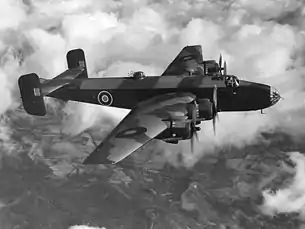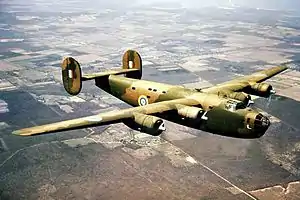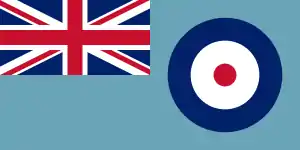No. 4 Group RAF
No. 4 Group was a Royal Air Force group, originally formed in the First World War, and reformed in the wake of the Second World War, mostly part of RAF Bomber Command, but ending its days in RAF Transport Command.
| No. 4 Group RAF | |
|---|---|
| Active | 1 April 1918 – 24 March 1919 1 April 1937 – 2 February 1948 |
| Country | |
| Branch | |
| Part of | RAF Bomber Command (April 1937 – May 1945) RAF Transport Command (May 1945 – February 1948) |
| Group Headquarters | RAF Linton-on-Ouse (April 1937 – January 1940) Heslington Hall (January 1940 – February 1948) |
| Commanders | |
| Notable commanders | Marshal of the Royal Air Force Arthur "Bomber" Harris |
History
Formation in the First World War
No. 4 Group was originally formed in October 1918 at the Seaplane Experimental Station, Felixstowe just before the end of the First World War and disbanded a year later in 1919. In its first incarnation, No. 4 Group was created by augmenting the former Royal Naval Air Service group at RNAS Great Yarmouth which had been responsible for anti-submarine and anti-Zeppelin operations over the North Sea. The former RNAS group was designated as No. 73 Wing within the new No. 4 Group. The commanding officer of No. 4 Group was Colonel C R Samson.[1] With the 1918–1919 postwar demobilization of the RAF, No. 4 Group was disbanded on 24 March 1919.
Reformation in the Second World War

With the buildup of the RAF prior to the outbreak of the Second World War, No. 4 Group was reformed on 1 April 1937 as part of RAF Bomber Command based at RAF Mildenhall, Suffolk under A/Cdre Arthur Harris (later Air Vice-Marshal "Bomber" Harris). On 29 June 1937 the headquarters were relocated at RAF Linton-on-Ouse, Yorkshire when 4 Group took over a number of stations and squadrons from No. 3 Group RAF. 4 Group was primarily based in Yorkshire for the duration of the war. Its airfields became further concentrated south and east of York when 6 Group was formed (1 March 1943) using airfields north of the city.[2] The flying units of those were these, mainly flying with the Handley Page Heyford biplane bomber:

| Base | Squadron | Aircraft | Version |
|---|---|---|---|
| RAF Dishforth | No. 10 Squadron RAF No. 78 Squadron RAF | Handley Page Heyford Armstrong Whitworth Whitley Handley Page Heyford | Mks.IA, III Mk.I Mks.II, III |
| RAF Driffield | No. 77 Squadron RAF No. 102 Squadron RAF | Hawker Audax Handley Page Heyford | Mks.II, III |
| RAF Finningley | No. 7 Squadron RAF No. 76 Squadron RAF | Handley Page Heyford Vickers Wellesley Vickers Wellesley | Mks.II, III Mk.I Mk.I |
| RAF Leconfield | No. 166 Squadron RAF | Handley Page Heyford | Mk.III |
| RAF Linton-on-Ouse (Previously at RAF Boscombe Down) | No. 51 Squadron RAF No. 58 Squadron RAF | Vickers Virginia Avro Anson Vickers Virginia Avro Anson | Mk.X Mk.I Mk.X Mk.I |
The group's first operation was on the night of 3 September 1939 when ten Whitley Mk.IIIs of Nos. 51 and 58 Squadrons took off to drop leaflets in the Ruhr and over Hamburg and Bremen. By this time the group had shrunk to six squadrons and the equipment had been standardised to the Armstrong Whitworth Whitley. RAF Finningley had gone over to No. 5 Group RAF and RAF Leconfield was "Under care and Maintenance" by No. 4 Group.

| Base | Squadron | Aircraft | Version |
|---|---|---|---|
| RAF Dishforth | No. 10 Squadron RAF No. 78 Squadron RAF | Armstrong Whitworth Whitley Armstrong Whitworth Whitley | Mks.I, IV Mks.I, IV |
| RAF Driffield | No. 77 Squadron RAF No. 102 Squadron RAF | Armstrong Whitworth Whitley Armstrong Whitworth Whitley | Mks.III, V Mk.III |
| RAF Linton-on-Ouse | No. 51 Squadron RAF No. 58 Squadron RAF | Armstrong Whitworth Whitley Armstrong Whitworth Whitley | Mks.II, III Mks.I, II, III |
The first land bombing mission was by 26 out of 30 Whitleys from Nos. 10, 102, 77 and 51 Squadrons detailed to attack the seaplane base at Hornum on 20 March 1940. In April 1940 the group moved its headquarters to Heslington Hall, near York. In August/September 1940 No. 4 Group took part in eight attacks on Berlin, oil targets and ports. On 1 April 1941 104 Squadron was formed at RAF Driffield as part of No. 4 Group, equipped with the Vickers Wellington and carried out night bombing operations from May 1941 until February 1942.
On 24 July 1941, 4 Group dropped 2,000 lb bombs on the Scharnhorst and Gneisenau and helped to keep these battle-cruisers locked in Brest until 12 February 1942. By January 1942 the Group had grown considerably and was made out of the following flying units, which were in full conversion from the Whitley to the Vickers Wellington medium and Handley Page Halifax heavy bomber:

| Base | Squadron | Aircraft | Version |
|---|---|---|---|
| RAF Dishforth | No. 51 Squadron RAF | Armstrong Whitworth Whitley | Mk.V |
| RAF Driffield | No. 104 Squadron RAF | Vickers Wellington | Mk.II |
| RAF Leeming | No. 10 Squadron RAF No. 77 Squadron RAF | Handley Page Halifax Armstrong Whitworth Whitley | Mk.II Mk.V |
| RAF Leconfield | No. 98 Squadron RAF | Armstrong Whitworth Whitley | Mk.V (non-operational) |
| RAF Linton-on-Ouse | No. 35 Squadron RAF No. 58 Squadron RAF | Handley Page Halifax Armstrong Whitworth Whitley | Mks.I, II Mk.V |
| RAF Middleton St. George | No. 76 Squadron RAF No. 78 Squadron RAF | Handley Page Halifax Armstrong Whitworth Whitley | Mks.I, II Mk.V |
| RAF Pocklington | No. 405 Squadron RCAF | Vickers Wellington | Mk.II |
| RAF Stradishall | No. 138 Squadron RAF | Armstrong Whitworth Whitley | Mk.V |
| RAF Topcliffe | No. 102 Squadron RAF | Handley Page Halifax Armstrong Whitworth Whitley | Mk.II Mk.V (operational on Whitleys) |
On 30/31 May 1942 No. 4 Group played its part in the 1000 bomber raid on Cologne, providing 154 aircraft and the follow-up raid on Essen, providing 142 aircraft. In early 1943 No. 4 Group made a substantial contribution in the Battle of the Ruhr, which lasted until July. Losses were heavy but the results worthwhile. By March 1943 the group was made out of these flying units, conversion to the Halifax and Wellington was almost finished (some squadrons having still one or two Whitleys at hand):

| Base | Squadron | Aircraft | Version |
|---|---|---|---|
| RAF Burn | No. 431 Squadron RCAF | Vickers Wellington | Mk.X |
| RAF East Moor | No. 429 Squadron RCAF | Vickers Wellington | Mks.III, X |
| RAF Elvington | No. 77 Squadron RAF | Handley Page Halifax | Mks.II, V |
| RAF Leconfield | No. 196 Squadron RAF No. 466 Squadron RAAF | Vickers Wellington Vickers Wellington | Mk.X Mk.X |
| RAF Linton-on-Ouse | No. 76 Squadron RAF No. 78 Squadron RAF | Handley Page Halifax Handley Page Halifax | Mks.II, V Mk.II |
| RAF Melbourne | No. 10 Squadron RAF | Handley Page Halifax | Mk.II |
| RAF Pocklington | No. 102 Squadron RAF | Handley Page Halifax | Mk.II |
| RAF Rufforth | No. 158 Squadron RAF | Handley Page Halifax | Mk.II |
| RAF Snaith | No. 51 Squadron RAF | Handley Page Halifax | Mk.II |
In May/June 1944, 4 Group welcomed two French heavy-bomber squadrons - Nos. 346 and 347 Squadrons - to RAF Elvington. On that station a gradual changeover from RAF to French Air Force personnel was effected, so that by September 1944, the station was almost exclusively French and commanded by an officer of the French Air Force. In July 1944 the group looked like this, having pretty much standardised on the Halifax B.Mk.III:

| Base | Squadron | Aircraft | Version |
|---|---|---|---|
| RAF Breighton | No. 78 Squadron RAF | Handley Page Halifax | Mk.III |
| RAF Burn | No. 578 Squadron RAF | Handley Page Halifax | Mk.III |
| RAF Driffield | No. 466 Squadron RAAF | Handley Page Halifax | Mk.III |
| RAF Elvington | No. 346 Squadron RAF No. 347 Squadron RAF | Handley Page Halifax Handley Page Halifax | Mk.III Mks.III, V |
| RAF Full Sutton | No. 77 Squadron RAF | Handley Page Halifax | Mk.III |
| RAF Holme-on-Spalding Moor | No. 76 Squadron RAF | Handley Page Halifax | Mk.III |
| RAF Leconfield | No. 640 Squadron RAF | Handley Page Halifax | Mk.III |
| RAF Lissett | No. 158 Squadron RAF | Handley Page Halifax | Mk.III |
| RAF Melbourne | No. 10 Squadron RAF | Handley Page Halifax | Mk.III |
| RAF Pocklington | No. 102 Squadron RAF | Handley Page Halifax | Mks.III, IIIa |
| RAF Snaith | No. 51 Squadron RAF | Handley Page Halifax | Mk.III |
Prior to the invasion of Normandy in June 1944 intense attacks began on French marshalling yards and gun emplacements on the French coast, troop concentrations and V-weapon sites, reaching a peak in August when 3,629 sorties were flown. In addition No. 4 Group undertook urgent transport work and in little more than one week ferried 432,840 gallons of petrol to the British Second Army during Operation Market Garden.
In 1945, 4 Group attacked targets at Hanover, Magdeburg, Stuttgart, Cologne, Munster and Osnabrück plus the Sterkrade, Wanne-Eickel, Bottrop and many other synthetic-oil centres, bombing by day and night. Its attention later transferred to bombing railway centres in preparation for the crossing of the Rhine.
During the war 61,577 operational sorties were flown, the group trained many Bomber Command crews and helped to create two other bomber groups. On 7 May 1945 No. 4 Group was transferred to Transport Command, and by July 1945 the group consisted of the following flying units:
_G%C3%B3raszka_2008_151.JPG.webp)

| Base | Squadron | Aircraft | Version |
|---|---|---|---|
| RAF Bramcote | No. 105 OTU | Vickers Wellington Douglas Dakota | Mks.Ic, X Mks.III, IV |
| RAF Breighton | No. 78 Squadron RAF | Handley Page Halifax Douglas Dakota | Mk.VI Mk.IV |
| RAF Crosby-on-Eden | No. 109 OTU | Douglas Dakota | Mks.III, IV |
| RAF Driffield | No. 426 Squadron RCAF | Consolidated Liberator | Mks.VI, VIII |
| RAF Elvington | No. 346 Squadron RAF No. 347 Squadron RAF | Handley Page Halifax Handley Page Halifax | Mk.VI Mk.VI |
| RAF Full Sutton | No. 77 Squadron RAF | Handley Page Halifax Douglas Dakota | Mk.VI Mks.III, IV |
| RAF Holme-on-Spalding Moor | No. 76 Squadron RAF | Handley Page Halifax Douglas Dakota | Mk.VI Mk.IV |
| RAF Leconfield | No. 51 Squadron RAF | Short Stirling | Mk.V |
| RAF Lissett | No. 158 Squadron RAF | Handley Page Halifax Short Stirling | Mk.VI Mk.V |
| RAF Melbourne | No. 10 Squadron RAF | Handley Page Halifax | Mk.III |
| RAF Pocklington | No. 102 Squadron RAF | Handley Page Halifax | Mks.III, IIIa, VI |
| RAF Wymeswold | No. 108 OTU | Douglas Dakota | Mks.I, III, IV |
Commanders
- 1 April 1918 Colonel C R Samson
- 12 June 1937 Air Commodore Arthur T Harris
- 25 May 1938 Air Commodore C H B Blount
- 26 June 1939 Air Vice-Marshal Arthur Coningham
- 26 July 1941 Air Vice-Marshal C R Carr
- 12 February 1945 Air Vice-Marshal John R Whitley
- 7 May 1945 Air Vice-Marshal H S P Walmsley
- 15 December 1945 Air Vice-Marshal A C Stevens
- 2 October 1946 Air Commodore A P Revington
References
Citations
- Shepherd, E.C. (2004). "Samson, Charles Rumney". Oxford Dictionary of National Biography. Oxford University Press. Retrieved 4 June 2010.
- Otter 1998, p. 15.
- Halley 1988, pp. 38–235.
- Jefford 2001, pp. 30–67.
- Moyes 1976, p. 301.
- Moyes 1976, pp. 302–303.
- Moyes 1976, p. 304.
- Delve 1994, p. 69
- Delve 1994, p. 81.
- Sturtivant and Hamlin 2007, p. 206.
Bibliography
- Donnelly, G.L. "Larry", DFM. The Whitley Boys: The Story of No. 4 (Bomber) Group's Operations in the first year of WWII. New Malden, Surrey: Air Research Publications, 1991. ISBN 1-871187-11-7.
- Halley, James J. The Squadrons of the Royal Air Force & Commonwealth 1918-1988. Tonbridge, Kent, UK: Air Britain (Historians) Ltd., 1988. ISBN 0-85130-164-9.
- Jefford, C.G. RAF Squadrons, a Comprehensive record of the Movement and Equipment of all RAF Squadrons and their Antecedents since 1912. Shrewsbury, Shropshire, UK: Airlife Publishing, 1988 (second edition 2001). ISBN 1-85310-053-6.
- Moyes, Philip J.R. Bomber Squadrons of the RAF and their Aircraft. London: Macdonald and Jane's (Publishers) Ltd., 2nd edition 1976. ISBN 0-354-01027-1.
- Otter, Patrick. Yorkshire Airfields in the Second World War. Hushion House. 1998. ISBN 1853065420.
- Sturtivant, Ray, ISO and John Hamlin. RAF Flying Training And Support Units since 1912. Tonbridge, Kent, UK: Air-Britain (Historians) Ltd., 2007. ISBN 0-85130-365-X.
